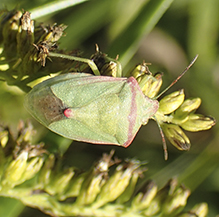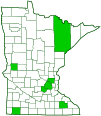red-shouldered stink bug
(Thyanta custator)
Conservation • Description • Habitat • Ecology • Distribution • Taxonomy
Conservation Status |
|
|||||||
| IUCN Red List | not listed |
|||||||
| NatureServe | NNR - Unranked |
|||||||
| Minnesota | not listed |
|||||||
Description |
||
Red-shouldered stink bug is a common, relatively small stink bug. It occurs throughout the United States, in southern Quebec and Ontario Canada, and in Mexico. It is relatively uncommon in the Upper Midwest, including Minnesota. Adults are found from May to October in open meadows and at the borders of agricultural fields. They feed on the foliage of plants from a wide variety of species in 14 plant families. They are a minor pest on a variety of agricultural crops, including beans, corn, peaches, and wheat. Adults are ⅜″ to ½″ (10 to 12 mm) in length. The body is broadly oval, about twice as long as wide, and almost parallel sided. It appears broad-shouldered and somewhat shield shaped. It is slightly convex when viewed from the side. The color is highly variable. The spring and summer brood is pale green or greenish yellow. The fall brood is usually dark brown or light tan, sometimes yellowish, sometimes green. The following description is of the green form. The head is small, flat, about as wide as long, and broadly rounded in front. The antennae are slender, and they have five segments. The first segment is short. The third segment is shorter than the second, fourth, and fifth. The first two segments and the first half of the third segment are green. The fourth and fifth segments and the last half of the third segment are orangish-brown or yellowish brown. The thorax is more than twice as wide as long. The exoskeletal plate covering the thorax (pronotum) is strongly sloping on the front half, narrow behind the head, and broadest near the rear. The shoulder (humeral) angles are usually broadly rounded, sometimes acutely angled, rarely extended into a short sharp spine. The lateral margins are straight or very slightly concave. The surface is densely pitted (punctate). The punctures are very closely spaced and often merge together. There is sometimes a reddish band across the pronotum between the humeral angles, and there is sometimes reddish on the lateral margins. The plate between the wing bases (scutellum) is large and triangular. It is broad at the base and gradually narrowed to a U-shaped lobe at the tip. The surface is densely punctate. The punctures are arranged in transverse rows, and there are fine wrinkles between the rows. The tip of the scutellum is narrowly rounded and is sometimes reddish, orangish, or yellowish. The abdomen has a flattened, enlarged margin (connexivum). The connexiva are pale with six pairs of yellowish or orangish spots. When the hemelytra are closed, the connexiva are narrowly exposed. The underside of the abdomen is green. There are no rows of large black spots, but there is a small black dot near each spiracle. There are two pairs of wings, and they are held flat over the body when at rest. The forewings (hemelytra) are slightly longer than the abdomen. They are finely and rather evenly punctate. They have a thickened, leathery section at the base and a thin membranous section at the tip with a clear dividing line between the two. The thickened basal part is comprised of a narrow area (clavus) behind the scutellum when the wings are closed, and the remaining broad marginal area (corium). There are numerous scattered whitish spots on the corium, and many black, oblong spots or dashes on the membrane. _________________________ The above description refers to the subspecies Thyanta custator accerra. |
||
Size |
||
Total length: ⅜″ to ½″ (10 to 12 mm) |
||
Similar Species |
||
Habitat |
||
Open meadows, borders of agricultural fields |
||
Ecology |
||
Season |
||
May to October |
||
Behavior |
||
|
||
Life Cycle |
||
|
||
Nymph Food |
||
Plant foliage |
||
Adult Food |
||
Plant foliage |
||
Distribution |
||||
|
Sources Revision of the genus Thyanta Stål, 1862 (Heteroptera: Pentatomidae). II. Central America, North America, and the West Indies. Rider D.A., Chapin J.B. 1992. J. N.Y. Ent. Soc. 100: 42-98. |
|||
| 11/29/2023 | ||||
Occurrence |
||||
Common |
||||
Taxonomy |
|||
Order |
Hemiptera (True bugs, Hoppers, Aphids, and Allies) |
||
Suborder |
Heteroptera (True Bugs) |
||
Infraorder |
Pentatomomorpha |
||
Superfamily |
Pentatomoidea (stink bugs, shield bugs, and allies) |
||
Family |
|||
Subfamily |
Pentatominae |
||
Tribe |
Pentatomini |
||
Genus |
Thyanta |
||
Subgenus |
Thyanta |
||
Thyanta custator and Thyanta pallidovirens are virtually identical in appearance. Thyanta custator was traditionally treated as a common Thyanta species with a coast-to-coast distribution. In a review of the two species (Ruckes, 1957), Thyanta pallidovirens became the widespread species. It was separated into four geographical subspecies, and Thyanta pallidovirens accerra became the northern and Midwestern subspecies, the only one occurring in Minnesota. Thyanta custator was restricted to the Gulf states and the Atlantic states from Florida to New York. A later review of the genus Thyanta (Rider and Chapin, 1992) reinstated Thyanta custator as the common, coast-to-coast species, and transferred Thyanta pallidovirens accerra to Thyanta custator accerra. At some point, Thyanta custator accerra was raised to full species level as Thyanta accerra. This move was not universally accepted. Much confusion remains regarding the proper classification of the northern and Midwestern Thyanta species. Some sources, including ITIS, NCBI, GBIF, and Encyclopedia of Life, classify it as Thyanta accerra, a valid species. Some sources, including BugGuide.net and iNaturalist, classify it as the subspecies Thyanta custator accerra. Both names are widely used. A few sources, including NatureServe, classify it as Thyanta custator with no subspecies. |
|||
Subordinate Taxa |
|||
red-shouldered stink bug (Thyanta custator accerra) red-shouldered stink bug (Thyanta custator custator) |
|||
Synonyms |
|||
Thyanta accerra Thyanta pallidovirens accerra |
|||
Common Names |
|||
red-shouldered stink bug |
|||
Thyanta custator custator and Thyanta custator accerra share the common name red-shouldered stink bug. Only Thyanta custator accerra occurs in Minnesota. |
|||
Glossary
Clavus
On Hemiptera: The hard part of the forewing that is adjacent to the scutellum when the wings are closed. Plural: clavi.
Connexivum
In Heteroptera: the enlarged, flattened margins of the abdomen. Plural: connexiva.
Corium
The thickened basal portion of the front wing that lies between the clavus and the membrane of insects in the family Hemiptera. Plural: coria.
Hemelytron
The forewing of true bugs (order Hemiptera), thickened at the base and membranous at the tip. Plural: hemelytra.
Pronotum
The exoskeletal plate on the upper side of the first segment of the thorax of an insect.
Punctate
Dotted with pits (punctures), translucent sunken glands, or colored spots of pigment.
Scutellum
The exoskeletal plate covering the rearward (posterior) part of the middle segment of the thorax in some insects. In Coleoptera, Hemiptera, and Homoptera, the dorsal, often triangular plate behind the pronotum and between the bases of the front wings. In Diptera, the exoskeletal plate between the abdomen and the thorax.
Visitor Photos |
|||||
Share your photo of this insect. |
|||||
| This button not working for you? Simply email us at info@MinnesotaSeasons.com. Attach one or more photos and, if you like, a caption. |
|||||
Babette Kis |
|||||
Chiwaukee Prairie, Kenosha Co., Wisconsin Thyanta custator, red-shouldered stinkbug, on Canada goldenrod, Solidago canadensis. Photographed at Chiwaukee Prairie, Kenosha Co., Wisconsin on Sept. 4, 2021. |
 |
||||
MinnesotaSeasons.com Photos |
|||||
|
|||||

Slideshows |
||

Visitor Videos |
|||
Share your video of this insect. |
|||
| This button not working for you? Simply email us at info@MinnesotaSeasons.com. Attach a video, a YouTube link, or a cloud storage link. |
|||
Other Videos |
|||


Created: 11/29/2023
Last Updated:

